
If you’re reading this, then you’ve probably decided to thru-hike the Te Araroa. If you’re on the fence, and trying to decide if the Te Araroa is right for you, I suggest you read my Te Araroa Thoughts written right after my hike. The end of that post pretty much sums up my warnings to anyone thinking about a TA thru-hike. It is a different experience from what most would consider a traditional “wilderness” thru-hike experience, and many are not aware of that going into it. You may want to seriously consider if it’s worth the time and money to do the TA over other options of thru-hikes (like all the ones listed on this blog) and travels around the world. Check out my post to make sure you’re going into this with the right expectations. Also, a fellow TA walker from my year (2016/17) wrote a great blog post that says much of what I feel about the TA, so I implore you to read Michelle Campbell’s “Things I Wish I Knew Before Hiking The Te Araroa From a New Zealand Girl Who Thought She Was Prepared.” She did an excellent job of communicating what many TA walkers feel after their experience. Plus, she saved me the effort of writing it myself, so “DITTO!” to what Michelle says in her post, and thank you for writing so honestly.
My goal in this post is to give a central location that will hopefully ease your planning by efficiently and concisely answering the FAQs that so many have while planning the Te Araroa. It seems that the majority of walkers along the TA are first time thru-hikers. This post is NOT going to address first time thru-hiker questions, but more trail specific ones that everyone will have as they delve into the detailed prep and planning. There is plenty of other information out there for those planning their first thru-hike, so I’m not going to add to that. I tried to remember my steps in planning, and to recall what my main questions and concerns were, so here we go. You might find some of this overkill, but I really used all of this in my planning and throughout my hike.
Have You Donated!?
If you have gotten this far, and are seriously planning a Te Araroa hike of any kind, you should have donated to the Te Araroa Trust by now. There are no permits needed to hike this relatively young trail, and NZ does not have much governmental funding for maintaining the trails. It’s only sensical that those who plan to use the trail pay it forward. I’m warning you now that trail karma is a powerful thing, and if you want to keep yours in check, you’ll pay it forward with a kind donation. I’m serious, DO IT NOW before proceeding any further!
It Ain’t Cheap
This is the warning that the Te Araroa is not an inexpensive thru-hike. I spent more on a monthly basis in New Zealand than any other thru-hike. Everyone is different, but I usually budget about $1000/mo if I include my bills like health insurance, phone bill, and any other monthly payments you may have. For the TA, it turned out to be more like $1500/mo. That’s a 50% increase. There will be small expenses the whole trail that add up along way that aren’t on most hikes. Charges for things like having no where to freedom camp legally many nights, basic wi-fi at hostels, more frequent gear replacement (i.e., shoes and clothing), more expensive food at the grocery stores, ferries and shuttles across many waterways, etc. These things do add up over time, and it’s best to know this ahead of time. My friend Suvi that I met along the trail broke down her expenses after the trail in a great way to show the reality of it. You’ll need to put it through Google Translate if you’re not Finnish. Beware that you’ll have trouble resisting spending a lot in the multitude of towns you’ll walk through on the North Island. Be sure to budget enough to enjoy the hike, and if you’re accustomed to more wilderness hikes where there are greater gaps from civilization and consumerism, be ready to adjust. Some think I say this as a complaint rather than a fact. I just want to give this warning up front so everyone knows what to expect. It’s a major factor in hiking the Te Araroa that is often overlooked or goes unmentioned. It ain’t cheap.
How to Apply for a NZ Visa
Seriously, did you donate? You should only be reading this far if you did! This is my experience as a US citizen, so this may be different for other countries. I used the New Zealand Government’s Immigration website to apply online. I found the process of getting a NZ Visa to be intimidating and time consuming, but it ended up working out just fine. I had my visa within a month of submitting the application. It would have been even sooner, but I was contacted a couple weeks after the initial application to provide more details about my finances and the reasoning for such an extended trip. You will be asked for a lot of documentation to show that you are financially capable of supporting yourself for the length of your visit, and can afford the flight out. I got the longest time available, a 9 month visa, so that I had plenty of time if anything unexpected came up that would extend the trip. A popular option for people with less in the bank is the Working Holiday Visa that allows visitors 18-30yrs old to stay up to a year and have the option to work if needed. It varies by country, so use the link above to select “work” and then “nationality” to see what the requirements are for your nationality. I would say that most international hikers under the age of 30 had that visa.
Flight Strategies
Especially for Americans, flights to NZ can be one of the most expensive flights out there. For the cheapest options, I recommend using momondo.com. Since there isn’t an airport near the start of the trail, most fly into Auckland and take a bus up north (I’ll explain this in more detail later in this post). I really don’t recommend getting a return flight unless you are really definite about that date for some reason. Although it might cost a couple hundred more to do two one way flights rather than a roundtrip, it is very freeing to have an open ended option. I didn’t buy my flight out until 2-3 weeks before I left. I met many people who finished and continued on to travel in different countries with people they met along the trail. I know others who quit halfway and decided their time would be better spent on tropical islands or other adventures. Some got injured and needed to get off trail. My point is, you never know, and it’s nice to not be locked into an arbitrary date and destination.
However, you might need proof of a return flight to get through customs at the airport. It seems random who gets asked for this and who doesn’t. I knew there was a chance of that, and I warn people that others have had to buy return tickets on the spot if they want to board their plane, so you need to bring some kind of proof of a flight out of NZ. Here’s how that can be done. Book a return flight (I suggest for the latest date you plan to stay) on orbitz.com (or any other site that allows 24hr cancellation). Once you book the flight and get an email confirmation with all the details that you can print, you can cancel the flight at no charge within 24hrs. Be very careful to make sure the site you’re on allows this for the particular flight you are booking if you plan to use this strategy. I suggest that you choose an airline other than the one you are booked to fly in on. That way, if for some reason, they try to check the flight internally, they can’t on their own system. I don’t know anyone that’s ever had a problem with this strategy, but I warn that it’s to be done at your own risk.
Lastly, there is a way to save a ton of money by getting flights for free. This is new to me, but it is catching momentum, and I may give it a try. I know people who have used the Travel Hacking strategy to get points on credit cards for free flights. It requires some good organization, awareness of finances, and the ability to pay off credit cards monthly, but can save you tons when done correctly. I don’t know if I have the organization to pull it off, but envy those that do!
Oh, and when you do fly, NZ can be very strict on what is brought into the country. Honestly admit what you’re carrying. They will not allow gear or shoes with major amounts of dirt or dried mud on them. They are quite thorough, even removing my tent and looking inside it to find a spider was in there when I was coming over from Australia, where I’d been backpacking. They rush it away behind the scenes and I was sure it was gone for good, but then it was returned after a complete check was done and the spider was put in a vial.
Maps, Apps, and Docs, Oh My
There certainly isn’t a lack of information out there on the Te Araroa. I’m going to make it simple for you and list all you might need. DON’T buy “A Walking Guide To New Zealand’s Long Trail.” It is more of an attractive picture book more functional as a coffee table book. Here are the resources most used, and the important information to pull from each of those sources.
Te Araroa Website
The Te Araroa website is a great resource with many links. I’ll narrow it down for you.
- Trail Maps, Tracks, & Notes are intended to be updated in September each year. The Te Araroa Trust does an amazing job of offering these on their site to be downloaded FOR FREE! It is an incredible gesture and quite a lot of work. If you do not take the opportunity to DONATE TO THE TE ARAROA TRUST, and not just $20. Trail karma will come back to kick you in the ass if you don’t. There’s a lot of roots and mud out there, and I wouldn’t chance it if I were you. Pay it forward! I carried paper maps as a backup, but used my phone with the Te Araroa app (explained later) and never needed them. The notes are extremely helpful, so I had both digital and hard copies, but printed them minimized (double-sided, two pages on each side of paper) to save half the weight and paper.
- Trail Stories are a list of blogs from previous years. I found it helpful to find a blog of someone that seemed to be my pace/skill level and I used an app (e.g., Pocket, Instapaper) to save each entry offline on my phone. That way I could easily reference their blog while offline on the trail for advice on strategy and planning how long sections took them compared to trail note estimates. The trail notes include timing to do sections because the terrain can be so slow going that just knowing the distance is not an indicator. 5km can take anywhere from less than an hour to over 4hrs depending on the terrain. The notes tend to gauge time extremely conservatively. Know that once you get going, you may find yourself hiking 25-50% faster than the estimated times in the trail notes. You’ll get a feel for it as you go.
- The Trail Status section is good to check from time to time to know of any reroutes or closed sections that didn’t make it on the updated maps/notes each September. These unexpected things occur the whole length of the trail. You tend to hear by word of mouth or social media, but the official information will be posted on the trail status section.
Te Araroa Hiker App
New in 2016 was the Te Araroa Hiker App, which was hugely popular. Those familiar with the Guthook App used on most major US trails and some internationally, it is from the same creators. They are transitioning to the new name of Atlas Guides, but it looks identical. This app will be your very best friend with all the data you need. Paired with the TA Notes, it’s all you’ll use. Yes, it’s $40US for the full trail, and some griped at first, but once they tried it, they understood that it’s worth every penny. Be aware that this app improves with hiker feedback and comments within the app. They use the track also provided by the Te Araroa Trust, so there are times that it’s off a bit, but that’s what the TA has provided and Atlas Guides wants to maintain compatibility with the trail notes and whatever the TA Trust is basing their information on. If there’s a campsite where there shouldn’t be one (private land) please write it in the comments so developers know to remove it.
Te Araroa Wiki
I told you there’s a lot of info to wade through…there’s even a Te Araroa Wiki page! Most of it is redundant, but there was information on resupply locations I didn’t find anywhere else. I just saved those pages of information as pdfs on my phone and had them to look at all trail. Came in very handy for me and other hikers. Especially when you’re on a mountain top in the rain with service trying to order new shoes and don’t know where to send them.
Te Araroa on Facebook
I take a deep breath here, but do recommend getting on your class fb page. Here’s the link to the Te Araroa 2017-18 Facebook Group. It can honestly be one of the more annoying pages to be on for veteran hikers that have been doing this for years. There are SO MANY newbie hikers on there with basic questions clogging up the feed and asking questions that could be answered with a simple Google search or search of the group’s feed. However, once you get going on the trail, there are some helpful things posted by fellow hikers that can really help with knowing about specific trail conditions, helping to find a lost item, advice in certain town situations, etc. I was happy others I hiked with seemed to keep up with it, so I rarely needed to look at it myself. It can be helpful though and does give a good sense of community for the class to communicate as a whole. Also, if there is a trail closure or reroute, it tends to be announced quite quickly with updates on the page. There is a general Te Araroa FB page as well. That is where the TA CEO will post most pertinent announcements or topics. They tend to get reposted on the class page if they are really important if you don’t want to follow both.
Cell Phones & Wi-Fi
The two main providers in New Zealand are Vodafone and Spark. Vodafone has the best service overall along the trail. The main bummer was that I had plenty of data, but hardly any minutes to call out of the country, whereas in Australia, I could easily get almost unlimited calling home. So, I will warn you, finding a plan to actually call without using wi-fi is not really feasible in NZ. You’ll be mostly limited to wi-fi phone calls, so prepare for strained relationships and expect to see your friends stressing as they have to spend limited town time explaining to partners why they haven’t called home more. No bueno. On the plus side, I will say that I could easily text or call within NZ and feel like I had service more along the TA than any other trail I’ve ever done. It was usually multiple times a day, but I do cover more miles than most. Also, in town, there is wi-fi, but it will often be slow, and you’ll have to pay. It is rare to find unlimited wi-fi unless you go to a nice hotel. Even McDonalds prevents streaming over there and libraries are super slow with all the tourists trying to soak up all they can from there camper vans in the parking lot. I was able to maintain the blog, but it was sometimes time consuming if I had a lot of photos. Spark is cheaper with almost as good service along the trail as Vodafone, but provides less data. Spark has wi-fi boxes in many towns that look like phone booths, and if you stand near them, you get 1GB for free/day. Seems like a nice incentive, overall Spark had less reception, and who wants to stand out by a box at night to get extra data? I was able to buy my Vodafone SIM card at the airport for something like 25% less than in grocery stores/gas stations. They only last 2 months, and then you can recharge, but it was cheaper just to buy two and change cards once the first one ran out or you hit 2 months. You will be able to buy them anywhere if you don’t get them at the airport. There is a ton of catering to tourism, so it won’t be a problem to find a SIM card when needed.
Credit Cards & Debit Cards
There are credit cards and debit cards that don’t charge you foreign transaction fees. If you’re from the US, I can tell you that I used the Capital One Quicksilver Card. I’m sure others may be out there, but this one was pretty great if you can qualify. As for debit cards, you could get hit pretty big on fees at the ATMs with both the surcharges from the bank you withdraw from and then your own bank charging a foreign ATM fee. State Farm does not charge foreign ATM fees AND also reimburses up to $10/mo in ATM surcharges that you may incur from the foreign banks. That means that as long as you aren’t doing too many withdrawals in one month, you shouldn’t have any extra charges for using ATMs. You’re welcome:)
Food Options, Resupplies, Bounce Boxes, and Fuel
 Let’s start with the fuel question. You will have absolutely no problem finding both canister fuel or alcohol for stoves. If there is one thing the TA has plenty of, it’s towns. Again, NZ caters to tourists, so most towns of significant size should sell the canister fuel, which you won’t need to replace too often anyway. I use alcohol for my alcohol stove. In NZ, what you’re looking for is Methylated Spirits. It unfortunately comes in IL bottles and tends to be at least $5NZ. It can be found in the cleaning aisle of most grocery stores, but can sometimes be stored behind the customer service as some try to drink it as alcohol. It is great if you can get it clear, but sometimes, it is purple. I was not a fan because it tended to leave soot on the bottom of my pot and be a nuisance, but it worked. I rarely had to buy it because there can often be some extra at hostels left behind by others or other hikers will chip in on one while together.
Let’s start with the fuel question. You will have absolutely no problem finding both canister fuel or alcohol for stoves. If there is one thing the TA has plenty of, it’s towns. Again, NZ caters to tourists, so most towns of significant size should sell the canister fuel, which you won’t need to replace too often anyway. I use alcohol for my alcohol stove. In NZ, what you’re looking for is Methylated Spirits. It unfortunately comes in IL bottles and tends to be at least $5NZ. It can be found in the cleaning aisle of most grocery stores, but can sometimes be stored behind the customer service as some try to drink it as alcohol. It is great if you can get it clear, but sometimes, it is purple. I was not a fan because it tended to leave soot on the bottom of my pot and be a nuisance, but it worked. I rarely had to buy it because there can often be some extra at hostels left behind by others or other hikers will chip in on one while together.
As for resupplies, don’t send any on the North Island! I’ve always done resupply boxes and it was quite nice not to have to worry about that for the most part on the TA. There is food everywhere on the North Island and it will be tough to resist buying things or getting treated unexpectedly. You’ll almost always come into town with a lot of extra food, so you don’t want to send boxes when there really is a great amount of unknown as to how much you’ll have leftover from the previous leg.
Small shops along the road walks called a Dairy tend to have ice cream, sandwiches, and burgers. There are also Takeaway places with quick food like a burger and fries/chips or Chinese food that’s not quality, but easy to get. The only resupplies needed on the South Island were to St Arnaud and Arthur’s Pass. Some chose Boyle Village to avoid a long hitch into Hanmer Springs on a somewhat less traveled road, but most ended up wanting to take that hitch after coming off a tough leg into Boyle. I felt that it was totally worth it to take the time to relax in Hanmer and not send that box to Boyle Village. You won’t need to think about them until you get to Wellington at the bottom of the South Island. I sent mine from Wellington, but some chose to cross the ferry and go to the small town of Picton to then shop and send. That wasn’t convenient for most who tried it and personally, didn’t save enough money to be worth that strategy.
When you do send boxes or purchase gear to be delivered ahead, you can send to the post office through what is called Post Resante. Not all post offices accepted packages. An explanation of all this resupply stuff and how to send boxes is on the Te Araroa Wiki page under ‘Resupply.’ Look at all the links there and it will make sense. Great resource! Again, I had those links saved as a pdf offline and found them very useful. I did send a bounce box, which isn’t a must (with my laptop, shoes, socks, vitamins, my fav drink mix from the US, extra water bladders, etc) to friends I had in Auckland, Wellington, and Lake Tekapo. I enjoy having a bounce box, but that is a personal preference.
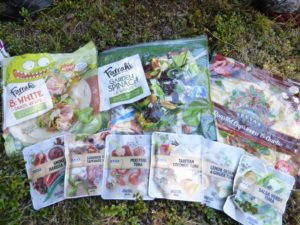
Flavored Tuna & Farrah’s Tortillas
As for food in NZ, I really took to it. Realize that it’s not cheap. You’re not going to find free refills on soda, there is no ketchup (they call it tomato sauce) unless you pay about 40 cents per packet, and don’t even get me started on the milkshakes. Sadly, if you want a thick milkshake that has some kind of flavor and actual ice cream in it, you’ll have to go to Burger King or McDonalds. I warn you now, you’ll pay $8NZ for a ‘thick shake’ (make sure you say thick shake if you don’t want chocolate milk) and you’ll get some kind of lukewarm frothy thing that doesn’t have ice cream in it and hardly more flavor than milk. It was heartbreaking so many times! You’ve been warned. There are things I’ll greatly miss though. Their burgers are grand. Everything tends to come on them if you order “the lot.” Even a fried egg, bacon, and pineapple. I grew to crave these and now a plain old American burger pales in comparison. As for trail food, almost everyone seemed to have the same main staple of the great flavored tuna packets they have in NZ and the aweseome Farrah’s Tortillas that came in a variety of flavors and were soft and durable like a Chipotle burrito wrap. Oh how I miss them!
Many people inquire as to what food they can bring into NZ. I heard it can be quite strict, so I chose not to risk it. I am not highly informed on this, but I heard that if it’s not meat or a ton of nuts, and is still in its original packaging, you should be ok.
Weather
The weather is a major factor in NZ (especially on the South Island). It can dump, and trails and valleys can rise and flood quickly. They can fall just as quickly when the rain stops, but you’ll want to definitely strategize your legs to hopefully dodge the rain as much as possible. I seemed to get a rainy year, so there can be some variance and other years are dryer. There are two sites (not apps) that are good for checking the weather that I had bookmarked on my phone and checked repeatedly. I found www.yr.no to be the most reliable, but given that you’re in NZ, the forecast can change even within a day. I like that the site ranges from seeing long term weather to also seeing hourly if you select that option. Weather was in mm of rain, rather than percentage chance, which was really annoying if you’re coming from the US. I never got used to that. The pattern seemed to often be that heavier rains would be predicted further out and then either move back or lessen as the day approached, but maybe that was just a coincidence. The other helpful site for the major mountain areas was metservice.com. You can type in the range or national park you’re in, and it often breaks it into specific areas with a forecast, but it only goes out a few days at a time in detail and doesn’t have it broken down hourly. For a country with such fickle weather, you’d think they’d have something more detailed.
Should I Only Do The South Island?
If there’s one question I get the most, it’s if the North Island is worth doing. I’m going to give my short answer here, but read my longer comparison of the two islands on my Te Araroa Thoughts post I mentioned before. Basically, if you’re short on time and money, and really want to do a thru-hike in NZ, just doing the South Island is definitely going to fit the bill. I’m not saying the North Island isn’t worth doing, but if you’re going to miss something, I’d say you’re not missing as much on the North Island. People who jumped in on the South Island had absolutely no problem getting their trail legs and then blending right in with the other hikers. Many have skipped much of the North Island, so people are not around just one group all hike. Walkers are used to seeing new people all the time, so it’s very common on this trail to jump in somewhere and be welcomed as if you were always there because that’s how it’s been the whole trail. People just appear, disappear, and reappear, so people on this trail are much more habituated to seeing new people and welcoming them as if they’ve been there all along. There are some things on the North Island that I would have been bummed to miss, it’s almost like 90mi beach and the Ratea Forest are a rite of passage in the first week or two. It’s unique to walk through the major cities of Auckland and Wellington. The Tongariro crossing is part of one of New Zealand’s Great Walks. The Tarauas are a quintessential NZ bushwalking experience. Plus, when else on a thru-hike will you get an opportunity to canoe a river for 4-7 days. Although the North Island isn’t the wilderness most seek in a thru-hike, the bonding that can happen over those two months with fellow hikers can be pretty cool. So, it’s a personal decision. If you have the time and money, and think it’s worth two months of your life over other options you might have, consider it. I enjoy the idea of walking a full country over 4-5 months, and that’s a rare thing to find in the world. Just that experience alone makes both islands worth it for me, but I also had checked off a lot of other things on the list to get to that point.
Huts & Hostels
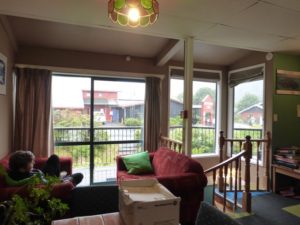
Relaxing in a hostel as rain falls outside.
YHA Hostels are in 16 towns along the TA. Other hostels exist, but many want to know if they should pay $22NZ to get a YHA Membership. It’s a close call on that one. In the end, I might have saved a bit more than the amount I payed for the membership. The membership is $25, and you get 10% off your stay, which tends to be around $30/night depending on the place and type of accommodation. So, if you think you’re going to stay at 9 YHA Hostels along the trail, then go for it. I’ll warn that they fill up quickly, so they aren’t always available. Also, some say on their sites that they offer free wi-fi for members, but it’s either some insanely low 500mb limit, really crappy wi-fi, or they tell you that was a misprint. Also, some people reason the membership purchase because they can get $22 off on the 1yr hut pass (costs $122NZ before the discount), but most TA hikers are only there for 5 months and can get the 6 month hut pass for $92NZ (no YHA discount available for that one). In the end, I say good luck trying to find a financial deal you win in NZ. There is a chance if you apply for the YHA Low Carbon Traveler. There are 7 YHAs listed along the trail that will give you 35% off if you are a TA walker and go through this application process. In the end I think you could maybe save a bit and come out on top IF you choose to stay in these towns and are lucky enough to nab a spot in these hostels that fill quickly. If you are wondering where to get your membership, you can join online or go to the YHA when you fly into Auckland. As for the hut pass, you won’t need it until the second half of the North Island, and you can also get it at any iSite (visitor center). Most go to downtown Auckland, but be ready that they have one person there who does go to lunch for about an hour each day, so time it well.
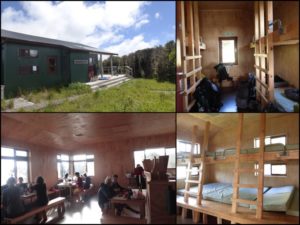
Pahautea Hut
As I mentioned, most get the 6mo hut pass for $92NZ. The price of huts vary, and some wonder if the hut pass really is more affordable than paying for them individually. I say just get the hut pass. It’s a lot simpler than trying to find out how much a hut will cost and then buying tickets. I think it will be well worth the money, but even if it doesn’t even out, it’s a donation to a very deserving safe haven along the trail. I did not go into the TA a fan of huts and communal sleeping, but I was so thankful for them!
Getting To The Start
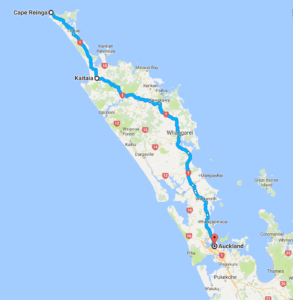
A visual to help envision this “fun.”
I find getting to the beginning of the Te Araroa to be very indicative of the whole trail experience. It is overly complicated, costs money, and eats up quite a bit of time. Here’s what you’ll most likely do. Fly into Auckland and then stay overnight so you can catch the early morning bus the next day to Kaitaia. I don’t know if there are any other bus companies that go to Kaitaia, but I booked (well in advance) with InterCity Bus for $68NZ. Some attempted to hitch and it took more than a day. It’s a four hour drive to Kaitaia from Auckland, but the bus takes just over six hours with a transfer in the middle as you see much of what you’ll be hiking the next 3-4 weeks. You’ll most likely be on the bus with a lot of other Te Araroa hikers. Once you get off, it will be about 2:30pm. Many got off and went to the post office to send boxes and to the grocery store for their first resupply. There is a YHA there, and many stayed the night (another ~$30), but I realized I had time to hitch to the start before dark, still 1.5hrs away at Cape Reinga. Most do hitch, but there are pricey tour buses up to Cape Reinga (details here if you’re interested) Others attempted the same thing hitching in the afternoon with varying degrees of success. There are multiple places to pay to camp off the highway if you don’t make the hitch all the way. I made it around 6pm, just in time to take a start photo and throw my tent up about 1km into the trail. Others made it late and slept at the bathrooms near the parking lot of the lighthouse. They were warned about rough locals possibly coming through the night and that did happen, so it really isn’t safely recommended to sleep close to the parking lot. Yep, if this is exhausting just reading it and you’re thinking, “all that and you haven’t even started yet!?” You’re right….welcome to the Te Araroa bitches! That’s just the beginning.
What’s This Canoe Thing?
If you’ve read about the Te Araroa, you know there’s a section that follows the Whanganui River. Don’t worry, you have plenty of time to figure this out as you walk and talk to other hikers. I walk fast, and I didn’t get to Taumarunui, where you’ll want to start looking into the Whanganui, at Day 38. There are many options explained in the trail notes. I explain it in more detail and you can see my daily experience with it starting with the end of this post on Day 46. People are concerned about needing to pair up, but what does happen is that there tends to be other solos looking to pair with people if you ask other hikers at the Holiday Park where everyone camps in Taumarunui. By the time you get there, you’ll have a feel for it and you’ll be comfortable with just asking whatever groups are there if you don’t have a pair. We had 16 people jump into our group just to bring the price down and got canoes for five days for $100/person once we went over 10 people. We used Blazing Saddles, but there are multiple options and there seems to be some small town infighting going on as well, so that made it interesting. I will warn to call ahead and check just to get a feel for how soon they are booking up. Around Christmas, they were fully booked and some people I knew had to take the option of biking or hiking, which is also an option if you’re not a fan of the water.
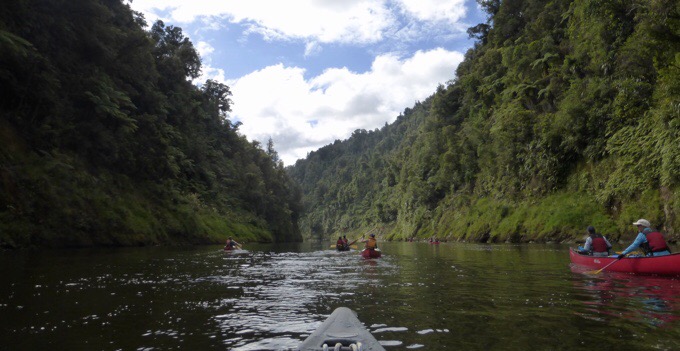
Gear Thoughts
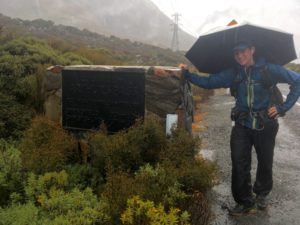
I think it always rains at Arthurs Pass.
I’m not going to go into gear too much, so people can see my gear list for what I use. Here are the few things I do want to mention. Many worry about having an ultra-light tent in the New Zealand winds. I will say there was a fairly even split in freestanding and non-freestanding tents, and it really shouldn’t be a concern. As long as you are experienced and level-headed enough to know your surroundings and check the weather, you’ll know if high winds or weather is coming and where to pitch safely. I had no problems at all. There are huts in most places once you get to the South Island, so there are safe options if weather gets too intense. I will recommend that you not skimp on the rain jacket, and to use function over weight with that. I loved having my umbrella! Again, all these things are on my gear list.
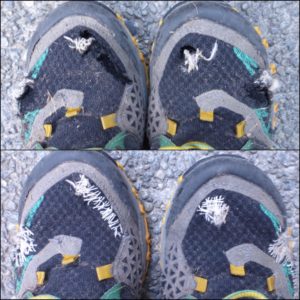
Dental floss shoe repairs.
Another main gear item to note of significance is shoes. Most thru-hikers wear trail runners. With all the brush, mud, and sand, shoes get torn up quick. Some preferred shoes with less mesh, but I stuck with what I regularly wore. Everyone learned to sew their shoes with dental floss where the mesh tore through, and it became quite the art for some. I’d say the most popular shoe out there this year was the Salomon trail running shoes (Crossmax or Speecross). Although there is a lot of wet feet on the Te Araroa, I DO NOT recommend getting waterproof shoes. They won’t stay dry, and once they are wet, they will never dry out. As for boots, good luck with that. Seeing people on the beaches and road walks with them, there were a lot of blisters and pains. So, no boots, but there are some mid-height shoes or shoes with less mesh that might have a longer lifespan. I tended to make it 500-700mi between pairs depending on the terrain. I was fortunate to have a bounce box with three new pairs of shoes, so I just gauged how my shoes were doing, and then sent them as I went. Shoes and gear are super expensive in New Zealand, so buy them ahead of time if you can or if you’re really particular about having the right shoe.
Bonus Side Trips
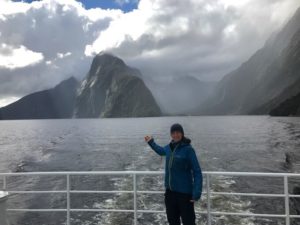
Milford Sound boat tour.
My last note is that I want to encourage people to do side trips along the way. I know it can be confusing and seem overwhelming to think about that now, but you don’t have to. The iSites (tourism centers) and Department of Conservation (DOC) Sites in New Zealand are very helpful. Pamphlets for side hikes can easily be found through the DOC website. I really enjoyed how user friendly it all was. Just about all my side trips were on the South Island. Many wondered about adding in Stewart Island at the bottom of the South Island. I know very few who felt that was worth it as it’s more of the same and you’ll have had your fill of sand and mud at that point. The one on the North Island that I would also recommend possibly adding is a day to do the full loop that continues from the Tongariro Crossing (I enjoyed adding the Mt Doom summit). It is known as the Northern Circuit and that is probably my one regret of a bonus trip opportunity that I passed up. Here is the list of what I did in the order that I did them. Some choose to finish their hike and then return to do the side trips, but I found it really enjoyable to do them along the way while I was in the area. I’ve linked each one so you can get an idea of where they fall in the hike and what town I reached them from.
–Abel Tasman
–Mt Cook-Mueller Hut
–Milford Sound Boat Tour
–Kepler Track
–Queenstown fun and Bungy/Swing
–Mt Aspiring Trip-Cascade Saddle & Rees Track (to Glenorchy)
–Routeburn & Caples Track
Finally, if you think you might finish by mid March, I would encourage you to apply for an Australian visa before the hike to have the option to go to Tasmania for a month or so. Weather can turn there in the end of April, but if you can make it before then, I highly recommend it. You’ll be in trail condition, and there is so much variety and fun to be had in Tasmania. Here’s a link to my month spent in Tasmania after the Te Araroa if you think you might be interested. I hope this post is helpful and makes the whole planning process a bit less taxing. Happy trails!
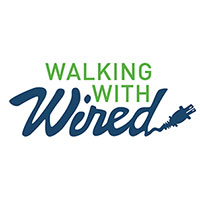


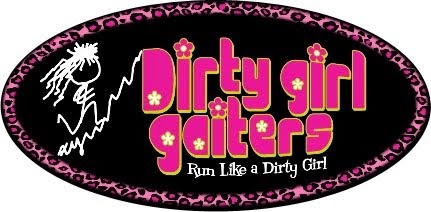





Awesome! Thanks for the write-up!
Especially for you;) Thanks for the push. It’s funny how the most difficult ones for me to write are the most helpful ones for others. This one took a lot of time, but I’m hoping it makes the planning a ton easier for so many others. I wish I had this. It’s a one stop shop for the while process. Let me know if anything is missing.
I’ve been looking at lots of blogs and other resources and don’t think I’ve seen a more complete overview than yours so far… I don’t believe anything is missing 😉
I particularly appreciate the side-trips part – not as much Information out there about possible side-trips than about gear etc^^
Oh sweet! I know there’s definitely no lack of info out there on the TA, so it may get lost in the pile, but I know many rely on my detail and tend to know I’ll steer them in the most efficient and direct way.
Your honest thoughts and comprehensive look back at NZ are, it seems to me, very informative for anyone thinking of hiking the Te Araroa. It’s a fascinating read.
You may recall that I traded email with you not long ago (during your hikes in Tasmania) about the possibility of doing a program on your adventure(s) for my Sierra Club Group (Loo Wit) in Vancouver, WA. I offered to meet with you to discuss it, but never heard back. There was some kind of issue that was never clear to me. If there’s a possibility of meeting you for coffee (my treat), let me know. If I don’t hear from you, I’ll take that as a “no.” Either way, thanks for considering us.
Lehman Holder
outings leader and executive committee (excom) member
Loo Wit Group/Sierra Club
Vancouver WA
Oh dang, I’m so sorry Lehman. I thought I did reply and I must not have. Sorry, hard to keep track of it all. I’m emailing you now.
I had already read Michelle’s warning. Her’s and your’s reads really upfront, honest.
Thank you very much for that overview.
I bought my flight return ticket just a few hours ago …
And you’re STILL going, ha! Have a great time:)
A great write up. I’ve missed getting email notifications from your blog! Btw, for years I’ve been following a hiker called “sheriff woody” and he is doing the CDT. He keeps mentioning that he leapfrogged a guy called Griggs and it just clicked that it’s your Griggs! Do you have Griggs Instagram address? Thanks x
Haha, cool. It is a small world Grigg’s Instagram is @griggsdomler.
Thanks for this write up. I was thinking off and on about doing this trail, and it sounds like a gigantic pain in the ass, and expensive. I planned on tenting up a lot, but you mention there weren’t many places to do that, was it just there weren’t many level spots or campsites? Did you try to stealth camp anyways?
Thanks.
Good question. I was thinking that too, as I was able to do the Appalachian Trail that way and avoid many towns and camp solo in the woods each night…but on the TA, the trick is finding a way to do that legally. Most of the North Island goes through private property…so you could illegally camp on people’s farmland, which some did, but if you’re looking to be legal, it is much tougher to find non-private land that’s free. They actually call it “free camping” whereas in the US, it’s just camping because we have so much public land and it’s more rare on the North Island. On the South Island, you can camp almost every night if you like.
Hey Wired! Thanks so much for the blog all the way from the High Sierra Trail to Tasmania! What a great year you’ve had! And super thanks for all the detail here. You’ve saved me a lot of poking around, although I’ll still do that of course. Coyote and I will be meeting up next Nov to do the TA, when she comes off Antarctica and I come off my summer adventures at home. After the wonderful wilderness of all our home trails, I found I loved the Camino as a great way to experience a new country on foot and I’m figuring the TA will be a cross between our wilderness and the cultural experience I had in Spain. Thanks for the frank look at the TA. After I finish I’ll be spending a month or more with Katie to van camp most of whatever I don’t get to on foot. Thanks again and lots of love! Comin at ya from a coffee shop overlooking the Mediterranean in Caesaria NP in Israel! Checking out sections of the INT for a future thru hike. Fell in love with the Negev!! That’s some serious desert and gorgeous. Thanks again, Shroomer
Knowing you Shroomer, you’ll find that silver lining in it. As you well know, the experience of a 4-5 month thru-hike is rare to find, and worth doing. Great that you have the van option afterward. I bet you’ll love that part the most since the trail doesn’t go to some of my favorite spots. It’s much more enjoyable from that mode of travel. Have fun in Israel!
Still not sure which rain jacket you used for this trip. OR Helium is in regular gear list but didn’t you take a sturdier rain jkt on this trip?
Good question, I did take the heavier rain jacket on my gear list that’s under the “other gear used on various trips when needed.” It was the Montbell Torrent Rain Jacket, which I love.
This blog is awesome ! Pictures of burgers being delivered to hikers on the roadside capturing Chirstmas in NZ. Look forward to meeting some of the people you discovered in NZ, beautiful people and country. Planning TA in 2017/18, your pictures and descriptions are invaluable. Cheers !
That was pretty awesome! Thanks for that reminder:)
Thank you!
thanks for writing this, it’s very helpful
unfortunately Michelle’s blog is not available anymore i wish i knew what her thoughts were, do you have any idea what other places i might be able to access it?
Hanieh, thank you for bringing that to my attention. Michelle had some changes to her blog, so the link changed. I’ve updated in my post above. Here it is for you https://michellecampbellnz.wordpress.com/2017/04/12/things-i-wish-i-knew-before-hiking-the-ta-from-a-new-zealand-girl-who-thought-she-was-prepared/
Thank you for your blog entries. At the moment I plan for January a NoBo hike of the Te Araroa.
Hi thanks for this beautiful hiking feedback ! I just can’t understand how you spend as much money, especially in food ! If the track is going throught a lot of town, should be easy to get some free food and free accomodation…
Food and accommodation doesn’t change just because we are hiking. It is just the same expense as any other tourist.
Hey there! I loved your post, but just wondered how many days it took you to do the TA? Cheers!
Hi, I have a homepage if you click the TA tap at the top of my website that gives stats and each daily post. I took 120 days including 7 days of no hiking and 13 days of hiking off the TA like doing the Routeburn and Kepler Tracks.